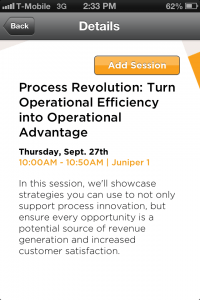We had a session of three papers this afternoon at BPM 2012 on how BPM is applied in different environments.
Event-Driven Manufacturing Process Management Approach
[link]
The first paper, presented by Antonio Estruch from Universitat Jaume I in Castellón, Spain, is on automated manufacturing, where several different information systems (SCADA/PLCs, MES, ERP systems) are all involved in the manufacturing process but possibly not integrated. These systems generate events, and this paper is on the detection and analysis of the complex events from these various systems, providing knowledge on how to handle these events while complementing the existing systems.
BPMN 2.0 is proposed to model the processes including the events; all those events that we love (or hate) in BPMN 2.0 are perfect in a scenario such as this, where multiple non-integrated systems are generating events, and processes need to be triggered in response to those events. This can be used for quality control, where the complex events can detect the potential presence of poorly manufactured items that may have escaped detection by the lower level instrumentation. This also allows the modeling and measurement of key performance indicators in the manufacturing processes.
There are some existing standards for integrating with manufacturing solutions, but more than this is required in order to make a usable BPM solution for manufacturing, such as easily configurable user interfaces for the manufacturing-specific event visualization, event management capabilities, and some data processing and analytics for assisting with the complex event processing over time.
They have been testing out this approach using manufacturing simulation software and an open source BPMS, but want to expand it in the future with more CEP patterns and more complete prototypes for real-world scenarios.
Process-Based Design and Integration of Wireless Sensor Network Applications
[link]
Stefano Tranquillini of University of Trento presented a paper on using BPM to assist in programming wireless sensor network (WSN) applications, which are currently stand-alone systems coded by specialized developers. These networks of sensors and actuators, such as those that control HVAC systems in meeting rooms using sensors for temperature, CO2, presence and other factors, have been the subject of other research, where the sensors are exposed as web services and orchestrated within processes, with an extension to process language specifically for sensors. The idea of the research described of this paper is to develop a modeling notation that allows integrated development of the business process and the WSN.
They created an extension to BPMN, BPMN4WSN, and created a modeling environment for designing the systems that include both business processes and WSN logic. This presents WSN interactions as a specific task type; since these can represent complex interactions of sensors and actuators, it’s not as simple as just a web service call, although this allows it to be abstracted as such within a BPMN model. The resulting model is both a deployable business process that deals with the business logic (e.g., billing for power consumption) and code generation for the WSN logic, plus the endpoints and communication proxy that connect the business process to the WSN.
Future work in this area is to make the code more efficient and reusable, create a unified modeling notation, create control flow for WSN nodes rather than the simpler sensors and actuators, and find a solution for multi-process deployment on a WSN.
You can find out more about the research project at the makeSense website.
Modeling Rewards and Incentive Mechanisms for Social BPM
[link to pdf paper]
Ognjen Scekic of the Vienna University of Technology presented a paper on incentives in social BPM, where he defines social business processes as those executed by an ad hoc assembled team of workers, where the team extends beyond the originator’s organizational scope. In addition to requiring environments to allow for rich collaboration, social processes in business require management and assignment of more complex tasks as well as incentive practices.
In general, incentives/rewards are used to align the interests of employees and organizations. A single incentive targets a specific behavior but may also have unwanted results (e.g., incenting only on call time in a call center without considering customer satisfaction), so typically multiple incentives are combined to produce the desired results. He makes a distinction between an incentive, which is offered before the task is completed, and a reward, which is offered after task completion. Consumer social computing uses simple incentive mechanisms, but that is insufficient for complex business processes; there are no general models and systems for modeling, executing, monitoring and adapting reward/incentive mechanisms.
The research identified seven major incentive mechanisms (e.g., pay-for-performance), each with its own evaluation methods. These can interface with the crowd management systems being used for social computing. Eventually, the idea is to have higher level tools so that an HR manager can assemble the incentives themselves, which will then be deployed to work with the social computing platform. Their Rewarding Model (RMod) provides a language for composing and executing these different incentive mechanisms based on time, state and organizational structure. Essentially, this is a rules-based system that evaluates conditions either at specific time intervals or based on inbound events, and triggers actions in response.
He described a scenario that used information from IBM India’s IT incident management system, generating automated team reorganization and monetary rewards in response to the work performed, as well as a scenario for a rotating presidency with a maximum number of consecutive times holding the position.
Although most of this work does not appear to be specific to social BPM, any of the incentives/rewards that result in automated team structure reorganization are likely only applicable in self-organized collaborative teams. Otherwise, these same methods could be applied to manage incentives in more structured teams and processes, although those likely already have incentive/rewards schemes in place as part of their structure.

